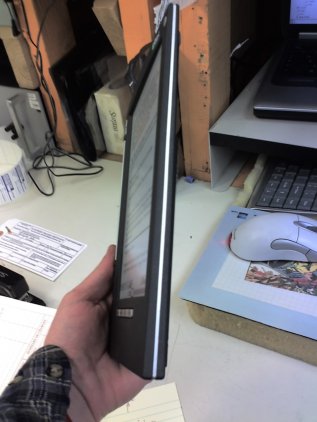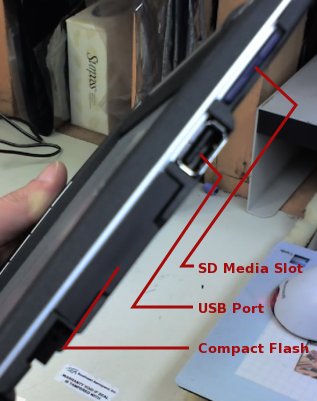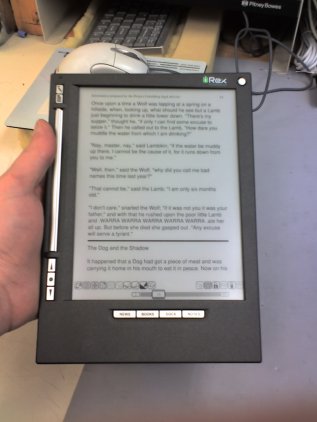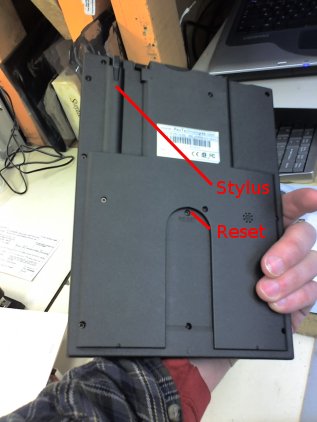 The iLiad is a roughly book-sized electronic device designed to display various forms of digital documentation and also allow you write functionality via a stylus and/or virtual keyboard. It can accept input from its built in wireless interface. a USB connected device, SD media or Compact Flash media cards. It features a 768×1024 pixel greyscale screen combined with a Wacom sensor board so that you can write on the screen with a Wacom stylus. Inside is a 400MHz Intel processor with 64MB of RAM coupled with 256MB of flash memory for the system. Half of which (128MB) is user accessible. The iLiad is a roughly book-sized electronic device designed to display various forms of digital documentation and also allow you write functionality via a stylus and/or virtual keyboard. It can accept input from its built in wireless interface. a USB connected device, SD media or Compact Flash media cards. It features a 768×1024 pixel greyscale screen combined with a Wacom sensor board so that you can write on the screen with a Wacom stylus. Inside is a 400MHz Intel processor with 64MB of RAM coupled with 256MB of flash memory for the system. Half of which (128MB) is user accessible. |
|
|
|
The wireless functionality incorporated into the unit means that is probably fairly easy to import new material into and out of the iLiad. This is probably a good time to mention what the iLiad is NOT. As far as I could tell, the iLiad has only limitted web functionality, so it is not a viable way to browse the web. It is also not a PDA, not an mp3 player, not able to send and receive instant messages, not a cellular phone. Nor does this $700 electronic book do a fraction of the things that most free cellular phones do. Therein lies the real downside to this otherwise excellent device. It does exactly what it is supposed to do extremely well but that is all it does. In an era when I can get a notebook computer that does so many things for $700, it’s hard to spend $700 on what is essentially just a book that people can read and scribble in. Now, granted, one might make the argument that it is not just one book. It can be any and/or many books. I was a little surprised to find that the iLiad I was testing came with only two books and neither of them were written by Homer. Not really a fan of Sherlock Holmes or Aesop’s Fables, I went online and found that iRex suggestted that I could download ka-gillions of free books from http://www.gutenberg.org/ and they were correct. Perusing through the stacks I could find almost every one of the old classics I was forced to read in school along with every other author I’d never heard of. I was in fear of total disappointment when I noticed that they had a book by Hemingway… oh wait…Percy Hemingway… yup, total disappointment. Time to pay my dues.
The iRex iLiad does a great job at presenting digital documents in an easy to use and easy to read format. It’s main shortcoming is its price. If I were earning a high six figures, I would buy one of these babies and load it up with every Louis L’Amour and Clive Cussler book available and give it to my father, saving him from substantial eye fatigue. If you are someone in an occupation that requires you to carry a lot of written documentation, I believe the iLiad would be a Godsend. It is not uncommon for pilots to carry a twenty or thirty pound chart case full of Sectional Maps, charts and airport directories. But for the rest of us, I can’t see the electronic book coming of age until the price of the appliances and ebooks comes down to a reasonable level. In the meantime, if you happen to be rich, my birthday is right around the corner. |
Categories
-
Recent Posts
Recent Comments
- Spark E. on Happy Thanksgiving
- Brian on Happy Thanksgiving
- Spark E. on Happy Thanksgiving
- Brian on Happy Thanksgiving
- Spark E. on Happy Thanksgiving
Archives
- November 2013
- May 2013
- December 2012
- September 2012
- May 2012
- February 2012
- December 2011
- June 2011
- July 2010
- December 2008
- November 2008
- December 2007
- August 2007
- April 2007
- January 2007
- December 2006
- October 2006
- September 2006
- March 2006
- February 2006
- January 2006
- August 2005
- June 2005
- November 2004
- October 2004
- August 2004
- July 2004
- April 2004
- February 2004
- January 2004
- August 2003
- July 2003
- May 2003
- February 2003
- January 2003
- December 2002
- October 2002
- September 2002
- July 2002
- June 2002
- March 2002
- February 2002
- January 2002
- September 2001
- July 2001
- April 2001
- February 2001
- January 2001
- December 2000
- November 2000
- October 2000
- August 2000
- July 2000
- June 2000
- April 2000
Meta

 It is designed to be able to read PDF, TXT, HTML, BMP, JPG and PNG files and has a built in Wi-Fi capable of 802.11B and G.I noticed that it has a standard 3.5mm headphone jack. However, I have no idea why except for a slight scuffing tone that it produces when a new page is produced. I am not sure if the sound is naturally the result of some process going on inside the unit or if they intentionally trying to emulate the sound cue of a turned page. The battery is a lithium-ion and should last a considerable amount of time given that the unique display only used power when refreshed IE: a page is turned.
It is designed to be able to read PDF, TXT, HTML, BMP, JPG and PNG files and has a built in Wi-Fi capable of 802.11B and G.I noticed that it has a standard 3.5mm headphone jack. However, I have no idea why except for a slight scuffing tone that it produces when a new page is produced. I am not sure if the sound is naturally the result of some process going on inside the unit or if they intentionally trying to emulate the sound cue of a turned page. The battery is a lithium-ion and should last a considerable amount of time given that the unique display only used power when refreshed IE: a page is turned. The first thing I will mention is the display. Perhaps the best feature of the iLiad is the iRex Technologies “Electronic Paper Display”. From what I can see, the eight inch display panel is not backlit as you would see on a typical laptop PC. With the unit turned off, the display appears fairly white. Or at least as white as the page of a book in normal indoor light. When the unit is turned on and text is displayed, there is no significant change in the appearance other than the text which seems to fade into view all at once rather than a line-by-line fashion. I would suspect that one would need an external light source to read from the display in dark conditions just like a book. Once the page is displayed, it no longer requires power for the pixels to maintain their current greyscale state. The quality of the text is impressive. It’s crisp, clear, adjustable and,in my opinion, better than many traditionally printed materials. Since the Electronic Paper Display only changes states when a new page is shown, the text does not need to be constantly refreshed. This means it does not rely upon the human “persistence of vision” effect to make a quickly flashing object look solid. The text is essentially solid – as if the pixels were physical tiles of a given shade of gray that only need to be turned when you want to make a new page. This makes the display incredibly easy on the eyes. The unfortunate side effect is that the display is unsuitable for displaying an animated image or video. Reading from the iLiad is a very comfortable and natural operation. Pages can be selected using the sylus or “turned” one by one using the large flipper control that runs along the left side of the display. The flipper bar can be toggled left or right to turn the pages backward and foreward one at a time or held slightly longer to turn five at a time. I found the flipper to be the most favorable tool. Although slightly counter-intuitive in that flipping to the left, which in my mind emulates turning to the next page in a book, actually turns to the previous page. Your state of mind may vary.
The first thing I will mention is the display. Perhaps the best feature of the iLiad is the iRex Technologies “Electronic Paper Display”. From what I can see, the eight inch display panel is not backlit as you would see on a typical laptop PC. With the unit turned off, the display appears fairly white. Or at least as white as the page of a book in normal indoor light. When the unit is turned on and text is displayed, there is no significant change in the appearance other than the text which seems to fade into view all at once rather than a line-by-line fashion. I would suspect that one would need an external light source to read from the display in dark conditions just like a book. Once the page is displayed, it no longer requires power for the pixels to maintain their current greyscale state. The quality of the text is impressive. It’s crisp, clear, adjustable and,in my opinion, better than many traditionally printed materials. Since the Electronic Paper Display only changes states when a new page is shown, the text does not need to be constantly refreshed. This means it does not rely upon the human “persistence of vision” effect to make a quickly flashing object look solid. The text is essentially solid – as if the pixels were physical tiles of a given shade of gray that only need to be turned when you want to make a new page. This makes the display incredibly easy on the eyes. The unfortunate side effect is that the display is unsuitable for displaying an animated image or video. Reading from the iLiad is a very comfortable and natural operation. Pages can be selected using the sylus or “turned” one by one using the large flipper control that runs along the left side of the display. The flipper bar can be toggled left or right to turn the pages backward and foreward one at a time or held slightly longer to turn five at a time. I found the flipper to be the most favorable tool. Although slightly counter-intuitive in that flipping to the left, which in my mind emulates turning to the next page in a book, actually turns to the previous page. Your state of mind may vary. Doodlers of the world, Unite!
Doodlers of the world, Unite! 